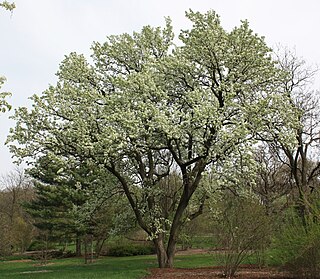
Pears are fruits produced and consumed around the world, growing on a tree and harvested in late Summer into October. The pear tree and shrub are a species of genus Pyrus, in the family Rosaceae, bearing the pomaceous fruit of the same name. Several species of pears are valued for their edible fruit and juices, while others are cultivated as trees.

Pyrus × bretschneideri, the ya pear or pearple or Chinese white pear, is an interspecific hybrid species of pear native to North China, where it is widely grown for its edible fruit.

Pyrus calleryana, or the Callery pear, is a species of pear tree native to China and Vietnam, in the family Rosaceae. It is most commonly known for its cultivar 'Bradford', widely planted throughout the United States and increasingly regarded as an invasive species.

Pyrus communis, known as the European pear or common pear, is a species of pear native to central and eastern Europe and southwest Asia.

Fruit commonly known as the Asian pear in different parts of the world include:

Pyrus salicifolia is a species of pear, native to the Middle East. It is widely grown as an ornamental tree, almost always as a pendulous cultivar, and is called by various common names, including willow-leaved pear, weeping pear, and similar. The tree is deciduous and of comparatively small stature, rarely reaching 10–12 meters in height. The crown is rounded. It has pendulous, silvery foliage, superficially similar to a weeping willow. The flowers are large and pure white highlighted with black-tipped stamens although the buds are tipped with red. The small green fruits are inedible, being hard and astringent.

The shipova is a hybrid of the European pear and the common whitebeam. It is a small to medium-sized tree growing to 10–18 m tall, with deciduous oval leaves 7–11 cm long and 5–6 cm broad. The fruit is a pome 2.5–3 cm long; it is edible with a sweet, yellowish flesh, which tastes similar to a Nashi pear.

Pyrus nivalis, commonly known as yellow pear, is a species of tree in the family Rosaceae that grows naturally from south-east Europe to western Asia. Like most pears, its fruit can be eaten raw or cooked; it has a mild sour taste. The plant is very colorful and may grow to a height of up to 10 meters and a width of about 8 meters. It is a very hardy plant that is able to withstand a small supply of water or very high or low temperatures. It may hybridize with other pears, producing, for example, Pyrus austriaca in a cross with Pyrus pyraster.
Elsinoë pyri is a species of fungus in the family Elsinoaceae. It is a plant pathogen that grows on apple. First described scientifically by Nikolai Nikolaevich Woronichin in 1914 as a species of Plectodiscella, the fungus was transferred to the genus Elsinoë by American mycologist Anna Eliza Jenkins in 1932.
Pyrus hakkiarica is a species of plant in the family Rosaceae. It is endemic to Turkey.

Pyrus pyraster, also called European wild pear, is a species of pear of the family Rosaceae.

Pyrus pashia, the wild Himalayan pear, is a small to medium size deciduous tree of the small and oval shaped crown with ovate, finely toothed leaves, attractive white flowers with red anthers and small pear-like fruits. It is a fruit bearing tree that is native to southern Asia. Locally, it is known by many names such as batangi (Urdu), tangi (Kashmiri), mahal mol (Hindi) and passi (Nepal).

Pyrus bourgaeana, the Iberian pear, is a close relative of Pyrus communis L. The last was domesticated about 2500 years ago. This monoecious small tree is widely distributed across the southern Iberian Peninsula and northern Morocco, where it coexists with four Pyrus species: P. communis L., P. cordata Dew., P. spinosa Forssk, and P. nivalis Jacq. Characteristics to discriminate these species are the width of fruit peduncle, petal size, leaf width and petiole length served to the taxa.

Xylomelum occidentale, commonly known as the western woody pear, is a tree species in the family Proteaceae. It is endemic to Western Australia.

Pyrus cordata, the Plymouth pear, is a rare wild species of pear belonging to the family Rosaceae. It gets its name from the city of Plymouth in Devon, where it was originally found in 1870 The Plymouth pear was one the British trees to be funded under English Natures Species Recovery Programme.

Pyrus syriaca is a deciduous tree in the Rosaceae family. It is referred to by the common name Syrian pear. It is the only pear species which grows in the wild in Lebanon, Turkey, Syria and Israel.

Pyrus amygdaliformis, also known as the almond-leaved pear, is a species of plant in the family Rosaceae. It is native to southern Europe, the Mediterranean, and west Asia. It grows to a height of 3–10 metres (9.8–32.8 ft). It has white flowers which bloom in April–May. The fruits are bitter and astringent. It hybridizes well with Pyrus communis and Pyrus pyraster.

Pyrus ussuriensis, also known as the Ussurian pear, Harbin pear, and Manchurian pear, is a species of flowering plant in the family Rosaceae.

Pyrus elaeagrifolia, the oleaster-leafed pear, is a species of wild pear plant in the genus Pyrus (Rosaceae), the specific name referring to the similarity of its foliage to that of Elaeagnus angustifolia - the so-called 'wild olive' or oleaster.
















